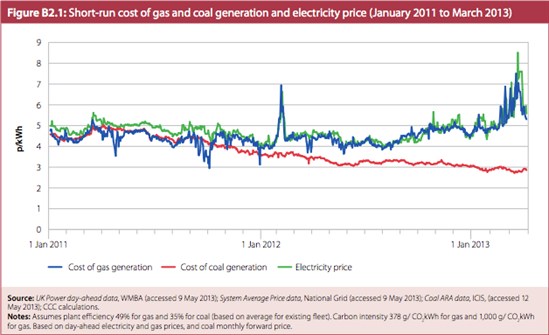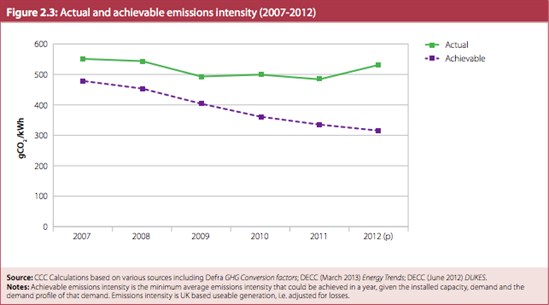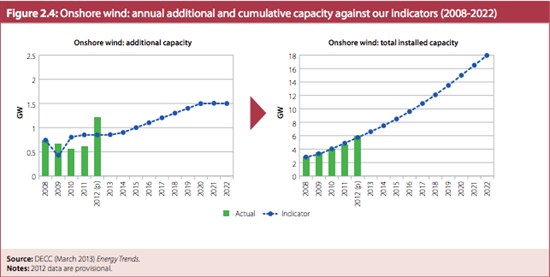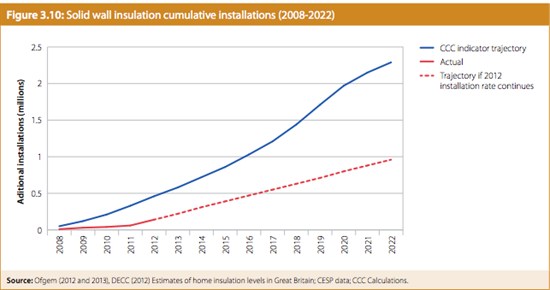Robin Webster
26.06.2013 | 10:25amWill the UK stick to legally binding targets to reduce greenhouse gas emissions 80 per cent by the middle of the century? The Committee on Climate Change (CCC) is warning that without effective government policies, the UK will start exceeding its planned carbon budgets before the end of the decade.
Under the terms of the 2008 Climate Change Act the government agreed to meet interim carbon budgets that set the amount of carbon dioxide the economy can produce over five year time periods. To meet them, emissions need to fall by about three per cent every year.
In its annual progress report to government, the CCC says the country is on course to achieve its carbon budgets up to 2017 – largely due to emissions reductions from the economic downturn.
But from 2018 onwards, “a significant increase in the pace of emissions reduction” will be needed, the CCC warns – otherwise the UK will exceed the carbon budgets that show the country is on track to decarbonise.
The UK’s emissions in 2012
Underlying changes like the rising cost of energy, slow growth in the UK economy and record levels of electricity from wind power should have meant that UK emissions fell by one to 1.5 per cent in 2012, the CCC says.
But a cold winter and and a fall in the price of coal – which meant the country burnt more coal and less gas – meant emissions actually went up by 3.5 per cent:
The changing cost of generating electricity from gas and coal in 2011 and 2012. The wholesale gas price increased by six per cent in 2012, while the wholesale price of coal fell by 11 per cent.
Burning gas instead of coal
The Committee recommends burning gas instead of coal whenever possible, as a short term way to cut emissions. By using lower-carbon technologies – nuclear, renewables and finally gas – to generate electricity in preference to high-carbon fuels, power sector emissions could be as much as 41 per cent lower, the Committee says:
A comparison of actual and ‘achievable’ emissions intensity. Actual emissions intensity is the rate at which greenhouse gas emissions are released when generating electricity. Achievable emissions intensity is the rate at which greenhouse gas emissions would be released, if low-carbon technologies were used in preference to high-carbon fuels.
In the longer term, the Committee predicts coal will stop displacing gas as pollution control measures introduced by the EU forces coal power stations to shut down, and the Treasury’s carbon price floor kicks in.
Not everyone agrees that’s going to happen though – Greenpeace recently argued that these policy measures aren’t strong enough and high levels of coal burning could continue well into the next decade.
More wind power
The growth in renewables has continued – they now generate 12 per cent of the country’s electricity. A record amount of wind power can online in 2012, 2.4 gigawatts onshore and offshore. And the report says there is a “healthy project pipeline” for further growth – if wind continues to be added at the same rate, the government will fulfill the Committee’s expectations up to 2020:
But delays in the details and disputes over the government’s energy bill are holding construction of windfarms up as investors wait to see what’s going to happen before they commit. The report repeats the committee’s call for the government to increase clarity about where energy policy is going.
Energy efficiency stalling?
The report echoes concern over whether energy efficiency policy measures are going to work.
The government predicts significant future emissions savings as a result of EU Products Policy, which sets energy efficiency standards for electrical appliances. In theory, as consumers replace their washing machines, televisions and lighting, the new models use less energy.
But the CCC – which has previously suggested there is a major gap between policy assumptions and the reality regarding the take up of efficient products – points out that the government no longer monitors the sale of energy efficient appliances, so it’s impossible to tell whether the measure is working or not.
Rates of loft and cavity wall insulation increased in 2012 – with 82,000 houses receiving solid wall insulation in 2012, compared to 11,000 in 2011, for example. But chief executive of the CCC, David Kennedy described this rate of growth to Carbon Brief as:
“…an increase from a very low level to a very low level, far below what we’re aiming to achieve on solid wall insulation”
More ambition is needed, the report suggests. The graph below shows the growth in solid wall insulation the CCC believes is needed in the future:
Policy may be going in the wrong direction. 2012 was the last year of the government’s old approach to energy efficiency – where fuel-poor households received free or subsidized insulation from energy companies.
Under the new Green Deal and Energy Company Obligation, householders will largely have to pay for the measures themselves. The CCC calls on the government to review and assess both programmes at the earliest opportunity.
Concerns
The report also expresses concerns about lack of progress in rolling out low-carbon heat and energy efficiency improvements in the commercial and industrial sectors – areas where it says the challenge is not building on previous progress, but getting any sort of progress going in the first place. It also calls for more food waste to be recycled as a way of reducing greenhouse gas emissions.
The government will respond formally to the Committee’s report in October.





